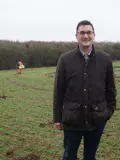Wood Farm is a working farm and family-run campsite situated to the south of Emberton in Milton Keynes. It is owned by Joseph Soul, a landowner looking to diversify the income of his land and create high-quality, landscape-scale habitats.
To help achieve his aim, Mr. Soul is working alongside Environment Bank to convert his land from low-yield arable farmland to a series of other habitats including neutral grassland, lowland meadow, hedgerows, and dense scrub, that will form a Habitat Bank to enable developers to meet their offsite Biodiversity Net Gain (BNG) requirements.
I was interested in Biodiversity Net Gain for a long while, so much so that I investigated looking at securing credits and launching them on the market myself.
However, I chose to work with Environment Bank on this project. Their knowledge, advice, and end-to-end support have been invaluable. It’s a process that needs to be overseen by a team of expert ecologists, to deliver the very best results for nature and my business. It simply removes the risk of the scheme failing and the need for significant upfront expenditure.
My work with Environment Bank also feels like a joint effort, and it’s clear that they care just as much as I do about making a positive change to my land. I have received no shortage of support. Its approach is fully funded, they cover all capital costs, and it guarantees an alternative income across a 30-year agreement. Also, it’s reassuring that all risks and long-term liabilities, typically associated with BNG, are mitigated.
Why did you choose Environment Bank's model?
It’s been a really comprehensive process so far. It began with the team of expert ecologists from Environment Bank doing all the necessary research to ensure the best possible future for my land. They combined cultural landscape studies with historical mapping data and a geological approach.
Then, a bespoke habitat management plan was put together within the scope of the Defra Biodiversity Metric to design the new habitats.
The yearly visits from Environment Bank were also planned to assess the Habitat Bank so that tabs are kept on the process of nature restoration. If anything needs to adapt to provide the best outcome for nature or increase the quality of my land, the team of expert ecologists can make the necessary changes.
What is the process so far?
In early January, planting is scheduled to commence.
This will result in the conversion of the arable fields into fields of predominantly neutral grassland, with an area of lowland meadow creation also proposed in the southwestern corner of the site. A series of hedgerows will also be planted on site, in addition to a belt of dense scrub adjoining the mature hedgerow/existing belt of scrub along the site's southeastern boundary. Over time we are expecting to see a dramatic increase in soil quality helping to rebuild the ecosystem services on the site, locking up water and carbon and helping to provide improved air and water quality locally.
The Habitat Bank is strategically in close proximity to existing ancient woodland providing ecological connectivity, this combined with the habitats proposed on-site excitingly has the potential to attract species native to the area not currently present. This may include species such as nightingale and garden warbler and turtle dove.
How will the ecosystem change?
We will receive funding to lease the land to Environment Bank for a minimum of 30 years, in return for managing the Habitat Bank. We receive an onboarding fee, the first year’s rent upfront, and then annual payments with fixed annual uplifts to counteract inflation.
Also, from a financial point of view, our campsite is sure to attract more customers if the land surrounding it is more biologically diverse. A greater range of plants and animals will increase the quality of the land, create a better landscape to visit, and very simply, offer a more aesthetically pleasing environment.
What financial benefits do you expect from creating a Habitat Bank?
Of course, the benefits reaped from protecting nature will be abundant, but a partnership with Environment Bank also allows us to guarantee an income for the next 30 years, which is a welcome bonus during the cost of living crisis across the UK.
If we hadn’t diversified our land with Environment Bank, it would be very difficult to see as much profit from the land.
The whole process only takes around three months from registration, meaning it's an efficient system and Environment Bank’s team of ecologists is always around to offer sound advice and expertise.
I think my main piece of advice for landowners and farmers would be to take the plunge. It doesn’t feel as scary knowing that Environment Bank is by your side throughout, and all risk and long-term liability are mitigated. It also feels great to know you’re doing your bit to combat the biodiversity crisis we’re currently facing in the UK, and therefore working against climate change.
What advice would you give to other farmers or landowners?
GET STARTED WITH HABITAT BANK CREATION
Find out the habitat options for your land and the income you could generate by registering your land or calling our team on 01904 202 990.







